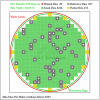Acer Swift 3 with Ryzen 7 4700U
AMD Ryzen 4000 Mobile APUs
AMD debuted (finally!) their Ryzen 4000 mobile chips at CES that are confusingly Ryzen 2 CPUs that are analogous with their Ryzen 3000 desktop parts.
I like what I see, especially on the power front. I know many people said that 7nm Ryzen chips had the potential to be very power efficient and if AMD's slide deck is to be believed they have succeeded. Most of the power efficiency has come from the 7nm process. As well, the 7nm process looks to be allowing AMD to cram up to 8 cores onto a laptop chip.
Do you guys think AMD has a product that will be as competitive on the laptop as the 3000 series is on the desktop? I'm thinking that the 4600 will be the best buy like the 3600 is in the desktop space. The problem in the laptop space is AMD needs design wins. At least on the desktop I don't need some company to choose for me, I can just by the chip myself.
AMD Ryzen 4000 Mobile APUs
AMD debuted (finally!) their Ryzen 4000 mobile chips at CES that are confusingly Ryzen 2 CPUs that are analogous with their Ryzen 3000 desktop parts.
I like what I see, especially on the power front. I know many people said that 7nm Ryzen chips had the potential to be very power efficient and if AMD's slide deck is to be believed they have succeeded. Most of the power efficiency has come from the 7nm process. As well, the 7nm process looks to be allowing AMD to cram up to 8 cores onto a laptop chip.
Do you guys think AMD has a product that will be as competitive on the laptop as the 3000 series is on the desktop? I'm thinking that the 4600 will be the best buy like the 3600 is in the desktop space. The problem in the laptop space is AMD needs design wins. At least on the desktop I don't need some company to choose for me, I can just by the chip myself.




